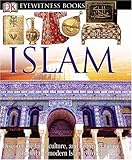Macauley'
 s 2003 work describes the creation of a fictitious mosque in the 16th century Ottoman Empire. He follows the architect and the financial donor as they decide how to construct the building. Macaulay is sensitive to the historical period and carefully explains the role of zakat, legal almsgiving, to justify the cost in constructing a mosque. His pictures and his explanations clearly show the role of a mosque in society; the important features of a mosque, specific to the Ottoman Empire in this era, but in many ways similar to mosques across historical and regional boundaries; and the surrounding buildings that would have likely been constructed alongside a mosque. With a long history of other architectural books for young adults, Macauley has a strong history in his field. I was pleased at his interpretation and sensitivity to a field that can often be contentious today.
s 2003 work describes the creation of a fictitious mosque in the 16th century Ottoman Empire. He follows the architect and the financial donor as they decide how to construct the building. Macaulay is sensitive to the historical period and carefully explains the role of zakat, legal almsgiving, to justify the cost in constructing a mosque. His pictures and his explanations clearly show the role of a mosque in society; the important features of a mosque, specific to the Ottoman Empire in this era, but in many ways similar to mosques across historical and regional boundaries; and the surrounding buildings that would have likely been constructed alongside a mosque. With a long history of other architectural books for young adults, Macauley has a strong history in his field. I was pleased at his interpretation and sensitivity to a field that can often be contentious today.As much as I enjo
 yed Macauley, I have to say, I liked Islam even better. Like the rest of the DK Eyewitness book series, this book is set up like a young adult's encyclopedia. Each page incorporates pictures and short explanations to further explain the religion and the society of Islam. What impressed me the most with this book was its ability to remain unbiased and historical. It would have been easy to oversimplify the history of Islam and try to describe one Islam that was relevant at all times. The authors of this work have not done so. There are pages that cover important historical era - Muhammad's life, the Crusades, the creation of the Ottoman Empire - and sections that cover diverse geographical areas - Mali, India, China as well as the more familiar (to Western readers) Arabian peninsula.
yed Macauley, I have to say, I liked Islam even better. Like the rest of the DK Eyewitness book series, this book is set up like a young adult's encyclopedia. Each page incorporates pictures and short explanations to further explain the religion and the society of Islam. What impressed me the most with this book was its ability to remain unbiased and historical. It would have been easy to oversimplify the history of Islam and try to describe one Islam that was relevant at all times. The authors of this work have not done so. There are pages that cover important historical era - Muhammad's life, the Crusades, the creation of the Ottoman Empire - and sections that cover diverse geographical areas - Mali, India, China as well as the more familiar (to Western readers) Arabian peninsula.Whether you have no experience with Islam and are looking for a basic introduction to the faith or you have a decent amount of knowledge but would like further clarification about particular details, I would strongly recommend this book. In fact, I don't doubt that my lectures the next few weeks will be better because I sat and read Islam and Mosque carefully.
2 comments:
I'll be interested to hear what your students thought about reading children's lit. What a wonderful idea! Those Eye Witness books are amazing...I remember doing unit plans in Ed. School utilizing those books.
The students seemed to really like the readings. They borrowed my hard copies to skim what I hadn't given to them. At least one student said she liked getting the information in that format since she did not have any background to draw on. Generally, a successful class.
Post a Comment